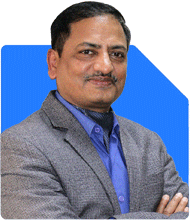38 Year Old With Moderate Risk Appetite - Can You Help Me With My Investment Portfolio?
Ramalingam Kalirajan |10014 Answers |Ask -Follow
Mutual Funds, Financial Planning Expert - Answered on Feb 17, 2025
He has an MBA in finance from the University of Madras and is a certified financial planner.
He is the director and chief financial planner at Holistic Investment, a Chennai-based firm that offers financial planning and wealth management advice.... more

Name- shubham Age-38 Objective - First time investing for an horizon of 15years for long term wealth creation. Risk appetite - Moderate (portfolio downfall upto 10-12) Monthly Sip - 35k Funds - icici gold saving- 2500 Icici multi asset - 7500 Parag parikh flexi - 10000 Hdfc flexi - 7000 Sbi nifty consumption index - 2500 Sbi technology opportunity -2500 Sbi healthcare opportunity - 3000 Query - 1. Is the funds chosen are fine. 2. Do i need change the allocation 3. I want to invest lumpsum of 20lakhs additional. In what ratio and in which fund i should allocate.
Evaluation of Current SIP Portfolio
The portfolio consists of equity, sectoral, multi-asset, and gold funds.
Exposure to sectoral funds is slightly high, increasing concentration risk.
Gold allocation is small but useful for diversification.
Multi-asset allocation adds stability, but its performance depends on asset allocation.
There is a good balance of flexi-cap and diversified equity funds.
The index-based fund is not ideal due to its passive nature.
Actively managed funds provide better flexibility and scope for higher returns.
Recommended Portfolio Adjustments
Reduce exposure to sector-specific funds to lower concentration risk.
Shift from index-based funds to actively managed funds for better risk-adjusted returns.
Maintain gold allocation but avoid excessive investment in it.
Multi-asset funds can remain but should not dominate the portfolio.
Maintain flexibility by investing in funds with broader diversification.
Revised SIP Allocation Suggestion
Reduce sector funds allocation to limit risk.
Increase allocation to diversified and flexi-cap funds.
Maintain gold exposure only for stability and not for wealth creation.
Focus on long-term equity growth for wealth accumulation.
Utilisation of Rs 20 Lakh Lump Sum Investment
Investing in a staggered manner reduces market timing risk.
Use a systematic transfer plan (STP) to invest gradually into equity.
Allocate based on risk-adjusted growth potential.
Avoid placing too much in sectoral or thematic funds.
Suggested Lump Sum Investment Allocation
Large & Flexi-Cap Funds: 50% for stability and growth.
Mid & Small-Cap Funds: 25% for high-growth potential.
Multi-Asset or Balanced Funds: 15% for risk management.
Gold & Debt: 10% for safety and diversification.
Final Insights
Your investment plan is structured well but needs small adjustments.
Reduce sector fund allocation and move towards diversified funds.
Avoid index funds and focus on actively managed equity funds.
Invest the lump sum amount through STP to reduce risk.
A disciplined and long-term approach will help achieve financial goals.
Best Regards,
K. Ramalingam, MBA, CFP,
Chief Financial Planner,
www.holisticinvestment.in
https://www.youtube.com/@HolisticInvestment
You may like to see similar questions and answers below
Ramalingam Kalirajan |10014 Answers |Ask -Follow
Mutual Funds, Financial Planning Expert - Answered on Apr 17, 2024
Sanjeev Govila | Answer |Ask -Follow
Financial Planner - Answered on Mar 28, 2024
Ramalingam Kalirajan |10014 Answers |Ask -Follow
Mutual Funds, Financial Planning Expert - Answered on Jul 29, 2024
Ramalingam Kalirajan |10014 Answers |Ask -Follow
Mutual Funds, Financial Planning Expert - Answered on Jan 30, 2025
Dr Nagarajan J S K |2095 Answers |Ask -Follow
NEET, Medical, Pharmacy Careers - Answered on Jul 30, 2025
Radheshyam Zanwar |5986 Answers |Ask -Follow
MHT-CET, IIT-JEE, NEET-UG Expert - Answered on Jul 30, 2025
Radheshyam Zanwar |5986 Answers |Ask -Follow
MHT-CET, IIT-JEE, NEET-UG Expert - Answered on Jul 30, 2025

Prefer ECE @ NITK Surathkal if possible. The final choice will be yours.
Good luck.
Follow me if you receive this reply..
Radheshyam
Dr Nagarajan J S K |2095 Answers |Ask -Follow
NEET, Medical, Pharmacy Careers - Answered on Jul 30, 2025

Radheshyam Zanwar |5986 Answers |Ask -Follow
MHT-CET, IIT-JEE, NEET-UG Expert - Answered on Jul 30, 2025
Ramalingam Kalirajan |10014 Answers |Ask -Follow
Mutual Funds, Financial Planning Expert - Answered on Jul 30, 2025
Ramalingam Kalirajan |10014 Answers |Ask -Follow
Mutual Funds, Financial Planning Expert - Answered on Jul 30, 2025
Ramalingam Kalirajan |10014 Answers |Ask -Follow
Mutual Funds, Financial Planning Expert - Answered on Jul 30, 2025
Radheshyam Zanwar |5986 Answers |Ask -Follow
MHT-CET, IIT-JEE, NEET-UG Expert - Answered on Jul 30, 2025
Ramalingam Kalirajan |10014 Answers |Ask -Follow
Mutual Funds, Financial Planning Expert - Answered on Jul 30, 2025





















